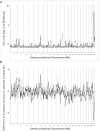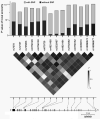MYH9 is associated with nondiabetic end-stage renal disease in African Americans
- PMID: 18794854
- PMCID: PMC2614692
- DOI: 10.1038/ng.232
MYH9 is associated with nondiabetic end-stage renal disease in African Americans
Abstract
As end-stage renal disease (ESRD) has a four times higher incidence in African Americans compared to European Americans, we hypothesized that susceptibility alleles for ESRD have a higher frequency in the West African than the European gene pool. We carried out a genome-wide admixture scan in 1,372 ESRD cases and 806 controls and found a highly significant association between excess African ancestry and nondiabetic ESRD (lod score = 5.70) but not diabetic ESRD (lod = 0.47) on chromosome 22q12. Each copy of the European ancestral allele conferred a relative risk of 0.50 (95% CI = 0.39-0.63) compared to African ancestry. Multiple common SNPs (allele frequencies ranging from 0.2 to 0.6) in the gene encoding nonmuscle myosin heavy chain type II isoform A (MYH9) were associated with two to four times greater risk of nondiabetic ESRD and accounted for a large proportion of the excess risk of ESRD observed in African compared to European Americans.
Figures



Comment in
-
Kidney disease and African ancestry.Nat Genet. 2008 Oct;40(10):1145-6. doi: 10.1038/ng1008-1145. Nat Genet. 2008. PMID: 18818713 No abstract available.
-
The genetic basis of kidney disease risk in African Americans: MYH9 as a new candidate gene.Am J Kidney Dis. 2009 Apr;53(4):579-83. doi: 10.1053/j.ajkd.2009.02.005. Am J Kidney Dis. 2009. PMID: 19324247 No abstract available.
References
-
- U.S.Renal Data System . In: USRDS 2007 Annual Data Report: Atlas of Chronic Kidney Disease and End-Stage Renal Disease in the United States. National Institute of Diabetes and Digestive and Kidney Disease, editor. National Institute of Diabetes and Digestive and Kidney Disease; Bethesda, MD: 2007.
-
- Klag MJ. End-stage renal disease in African-American and white men - 16-year MRFIT findings. JAMA. 1997;277:1293–1298. - PubMed
-
- Tarver-Carr ME, et al. Excess risk of chronic kidney disease among African-American versus white subjects in the United States: A population-based study of potential explanatory factors. Journal. of. the. American. Society. of. Nephrology. 2002;13:2363–2370. - PubMed
-
- Perneger TV, Whelton PK, Klag MJ. Race and end-stage renal disease. Socioeconomic status and access to health care as mediating factors. Arch Intern Med. 1995;155:1201–1208. - PubMed
-
- Lei HH, Perneger TV, Klag MJ, Whelton PK, Coresh J. Familial aggregation of renal disease in a population-based case- control study. J. Am. Soc. Nephrol. 1998;9:1270–1276. - PubMed
Publication types
MeSH terms
Substances
Grants and funding
- U01 DK057304/DK/NIDDK NIH HHS/United States
- U01DK57304/DK/NIDDK NIH HHS/United States
- DK07024/DK/NIDDK NIH HHS/United States
- M01-RR-000080/RR/NCRR NIH HHS/United States
- R01 DK059997/DK/NIDDK NIH HHS/United States
- M01-RR-00827-29/RR/NCRR NIH HHS/United States
- R01 HL062985/HL/NHLBI NIH HHS/United States
- N01 CO012400/CA/NCI NIH HHS/United States
- ImNIH/Intramural NIH HHS/United States
- U01DK57292/DK/NIDDK NIH HHS/United States
- M01 RR001346/RR/NCRR NIH HHS/United States
- K01 DK067207/DK/NIDDK NIH HHS/United States
- M01-RR-01346/RR/NCRR NIH HHS/United States
- HL62985/HL/NHLBI NIH HHS/United States
- HS08365/HS/AHRQ HHS/United States
- R01 DK067528/DK/NIDDK NIH HHS/United States
- M01-RR-00425/RR/NCRR NIH HHS/United States
- K01DK067207/DK/NIDDK NIH HHS/United States
- R01 DK072348/DK/NIDDK NIH HHS/United States
- M01 RR000425/RR/NCRR NIH HHS/United States
- M01-RR-07122/RR/NCRR NIH HHS/United States
- M01 RR007122/RR/NCRR NIH HHS/United States
- U01DK070657/DK/NIDDK NIH HHS/United States
- R01 HS008365/HS/AHRQ HHS/United States
- U01 DK057292/DK/NIDDK NIH HHS/United States
- M01 RR000827/RR/NCRR NIH HHS/United States
- M01 RR000080/RR/NCRR NIH HHS/United States
- N01-CO-12400/CO/NCI NIH HHS/United States
- U01 DK070657/DK/NIDDK NIH HHS/United States
LinkOut - more resources
Full Text Sources
Other Literature Sources
Medical
Molecular Biology Databases
Research Materials
Miscellaneous

